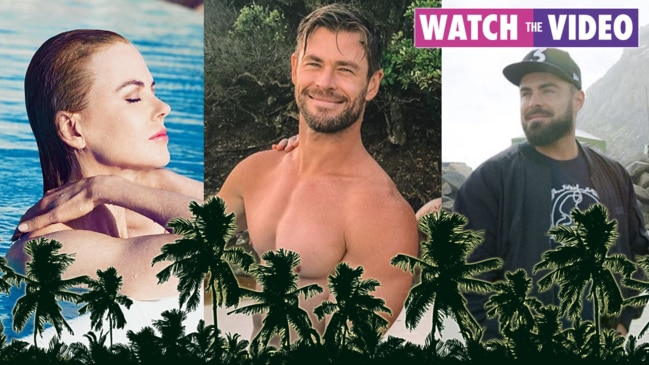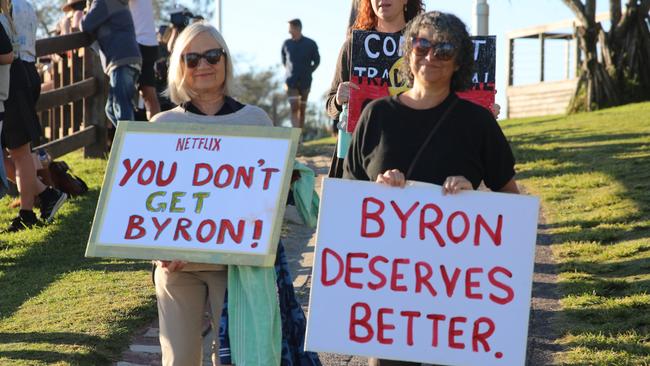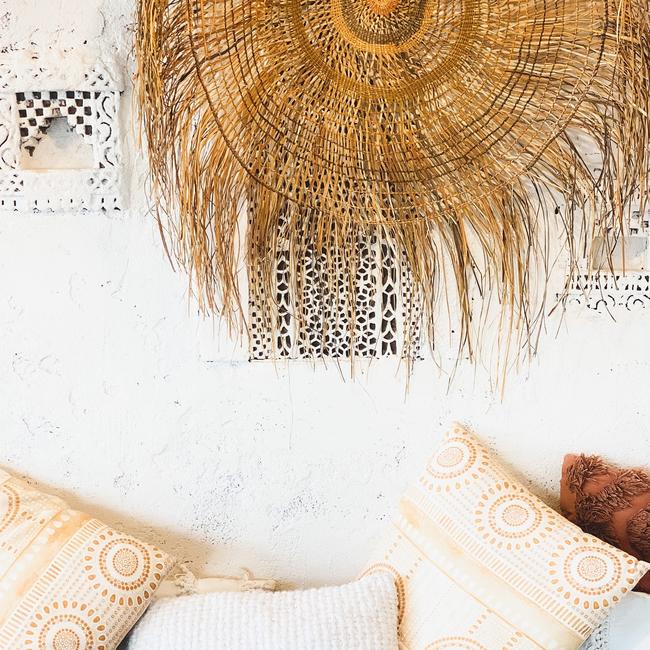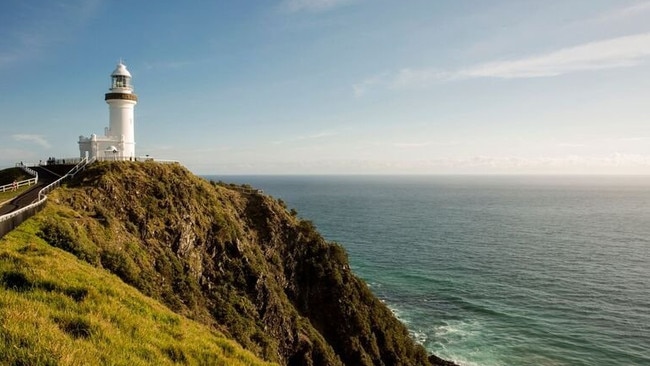There’s still something about Byron Bay beyond the Instagram influencers and beige linen
Despite the influencers, the divisive articles, and the unwelcome television crews, Byron Bay has retained its activist spirit and hippy roots.

When town planners mapped Byron Bay in 1884 they mistakenly believed Captain James Cook had named Cape Byron after the English poet Lord Byron – when in fact it was named after the poet’s grandfather, a navy admiral.
From that mistaken belief, say local historians, many of Byron’s streets were given the names of famous English poets or literary figures such as Wordsworth, Browning, Milton, Marvel, Jonson, Kingsley, Carlyle, Tennyson and Keats.
“It is more than a little ironic,” they note, “that the streets of Byron Bay, a very industrial seaport town until the 1970s, were named after men who were far from working class.”
Now, with television turning its lens on Byron Bay, we can add another layer of irony to this story.
A town mistakenly thought to be named after a rich European poet and his contemporaries is today synonymous with a new breed of image-conscious wordsmiths – the influencers.
From streets in the 19th century to cyberspace in the 21st, the point is not whether the connection to Byron (the man or the town) is true, but that the conjuring is enough to fire imaginations – for the purposes of colonisation then and chasing profit today.
Because hype doesn’t stand in for the real, there is still something very special about Byron Bay.
By the baes
When streaming giant Netflix issued a press release in early April announcing production was imminent on the doco-soap Byron Baes, negative reaction from the local community was fast and fierce.
Surfers paddled out to protest and locals brandished handmade signs reading: “Give Netflix the Flick” and “Byron’s Soul is not for Sale”.
Meanwhile, famous neo-locals, actor Chris Hemsworth and wife Elsa Pataky, threw a “white party” with A-list friends including Matt Damon (visiting from Hollywood) and some musos (visiting from Melbourne).
Netflix’s Byron Baes press release promised a bevy of “hot Instagrammers living their best lives, being their best selves, creating the best drama content #nofilter guaranteed”.
The tone was vacuous: “This is our love letter to Byron Bay, this is not just Chris and Zac’s backyard, it’s the playground of more celebrity-adjacent-adjacent influencers, than you can poke a selfie-stick at”.
RELATED: Byron Baes cast finally revealed

RELATED: Bizarre protest to stop Byron Baes
In any other town this misreading of place and lack of community consultation might have gone unnoticed. But not in Byron.
This is a community that ran Club Med out of town in the early 1990s (though a luxury “place sensitive” resort has since opened on the proposed site).
This is a town that has consistently fought off McDonald’s, KFC and other mega-franchises. The building limit is two storeys in the township and the local council has three Greens representatives, including the mayor.
In 1994, the Arakwal people, one of the tribes of the Bundjalung nation, lodged the first of three native title claims over the region. On December 28, 2000 the Arakwal signed the first Indigenous Land Use Agreement in the country, which stands internationally as a benchmark for Indigenous communities negotiating Native Title.

But the Bay is still bruised from a 2019 Vanity Fair article on local “murfers” (mum surfers) and Instagram stars. Many readers took pleasure in the way it skewered a group of privileged, linen-clad influencers with revelations about sponsorship and duplicity.
Others felt the piece was a nasty smear job.
So, Byron Baes was always going to be divisive. At the recent protests, filmmaker Tess Hall summed up local sentiment saying, “Trash TV equals trash town”. Many have suggested this ruckus was all part of Netflix’s plan – that the continuing coverage will only serve to provide free publicity.
Despite a 9500-strong petition and an emergency motion from council, filming has reportedly commenced.
Mind the gap
What’s happening in Byron Bay highlights the gap between constructed content and reality, between what happens on “the Gram” and people’s actual lives.
I want to see if recent events have dented the spirit of the Byron I know – whether, despite its battles, it still retains its restorative powers. I spend my first night with a friend in a treehouse-style whiskey bar, trying to reactivate my Insta account after a break of several years. We request and wait – my university firewall not playing ball.
My friend, much younger than me, keeps refreshing my email as if this delay is an affront to humanity.
It turns out our national broadcaster has already beaten Netflix to the punch and interviewed Byron Bay influencers for an upcoming Compass program Byron Bay: Australia’s Instagram Utopia. I chat with a couple of those featured during my visit.

When I tell Sarah Royall, adventurer and travel influencer with an eco-agenda that I’m not on Insta she looks at me like I’m an alien. But her bright-eyed positivity about the network potential of Instagram, what she categorises as a “new and emerging industry” is convincing. When travel restrictions ease, she plans to hold a sustainability retreat in French Polynesia involving coral reef and shark experts, scientists and marine biologists from around the world, all connected by social media.
Like the other women featured on the ABC program, Sarah deviates from the blatant objectification and product placement usually rife on Instagram.
There’s Angel Phoenix, a self-described radical astrologist who lives in a caravan. Jade Couldwell and Sophie Pearce, two friends and mummy influencers, who pose in various relaxed tree and sand tableaux with their golden-haired husbands and children.
Emica Penklis, an ex-model who now runs a successful organic chocolate company and Bunjalung woman Ella Noah Bancroft, a queer activist. Still, this is Instagram. They are all beautiful.
Colour and movement
Because Instagram demands beauty in whatever form it comes, beauty is the unspoken currency. Ella Noah Bancroft is uncomfortable about this aspect, smiling wryly when she says her words are linked to, “an often pretty egotistical photo … but it’s not about the photo for me, it’s about the caption”.
She recognises the power the platform provides her, but earns more money from her various roles in the community than she does from her social media presence – though the two are vitally interconnected.
Instagram appears to operate in this way for many – a nexus around which other opportunities, entrepreneurial ventures and side hustles occur. People becoming brands with faces and voices. What’s contained in the messaging is key.

The women talk about the importance of cultivating “relationships” with their “communities”, steering talk away from the machinations of the monetary value of influence.
Progressive narratives underpin or offset the images and commercialism – mental health, environmentalism, feminism, LGBTQI rights. While none of this could be read as altruistic, surely the ethical lean is positive.
That said, Penklis’ view is pragmatic. Her product is organic with a high price point.
So her social media feed is designed to attract a particular clientele, rather than highlight an agenda. She’s also refreshingly honest and tapped into the essential fact of Instagram influence: envy sells.
While Byron Bay might offer the promise of this enviable work life balance – pristine surf beaches, spa and wellness retreats, national parks – the business of influence can be hard work and switching off isn’t easy.
Royall has suffered from burnout and Bancroft is conscious about cultivating time away from technology. In the Compass program we see her working with other women in a communal garden. She tells me she often visits her mother on their nearby ancestral lands but does not document it.
“How many people can say that – that they can sit and talk with their mother for hours without looking at their phone?”

Being there
Byron Bay is a strange attractor – the Insta-driven celebrity wave, just the latest to roll in after the colonialists, whalers, hippies and the wealthy.
Sure, some young wannabes are lining up at sunset at the redeveloped Beach Hotel hoping to run into a Hemsworth brother and real estate is skyrocketing. But the roll call of visitors and locals remains eclectic. There are still old rockers holding up the bar at The Rails, glitter fairies busking on stilts in the main street while the well-heeled stroll by in their boat shoes.
Some spiritualists believe Byron and the surrounding area is a portal or energy vortex. The Arakwal believe it is a healing place where Indigenous women would birth in the ti-tree lakes. There’s definitely something in the water. Wave after wave, the same “cheer up, slow down, chill out” vibe washes over everyone.
On my final morning in Byron I head up to the Pass where another paddle out protest is scheduled – not against Byron Baes but PEP11, a major oil and gas venture threatening the precious marine ecosystem on the east coast. The bright blue day and the gathered crowd are impressive.
I don’t see any influencers or famous Hollywood actors, or even many people on their phones. Everyone radiates casual ease and community, standing about, or pooled under the eucalypts, boards strewn all over the place.
Jaded radio hosts like Mick Molloy may have paid out on the Byron community for going surfing as a form of protest (he suggests burning a wicker Hemsworth effigy instead). But when you’re here the gesture is powerful and symbiotic with a lifestyle tuned into consciousness raising.
Musician Billy Otto, a guy Byron Baes’ producers reportedly tried to recruit for the reality show, takes to the microphone. After his song and the speeches, the crowd flows down to the beach, surf warriors paddling out a model of a giant gas rig which they dismantle and bring back to shore.
Beyond them, further out to sea, my eye is drawn to Nguthungulli (Julian Rocks) where the Arakwal people say, their grandfather creator is resting. As the surfers form a circle, I’d wager it’s not the influencers, but Nguthungulli who draws so many people to Byron Bay. The most easterly point of the country. A place originally named Cavanbah, the “meeting place”.
On the way home my phone dies. I guess refreshing my Instagram self is going to have to wait.
This article originally appeared on The Conversation and was reproduced with permission
